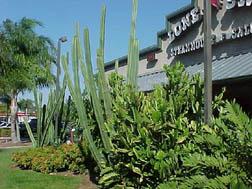|
Xeroscape
 Xeroscaping
(or xeriscaping) is a technology employed by landscapers in the western
United States to reduce the amount of water and maintenance it takes to
sustain a landscape project. Only plants and shrubs that are indigenous
to the area are chosen for plantings. The environment benefits because
these plants require little water and property owners benefit from the
low maintenace of plants that are intended for their climate and geography. Xeroscaping
(or xeriscaping) is a technology employed by landscapers in the western
United States to reduce the amount of water and maintenance it takes to
sustain a landscape project. Only plants and shrubs that are indigenous
to the area are chosen for plantings. The environment benefits because
these plants require little water and property owners benefit from the
low maintenace of plants that are intended for their climate and geography.
The Principles
of Xeriscaping
Water conservation is becoming a very important consideration when gardening
in the Western US. Back in 1981, an environmental planner for the Denver
Water Department coined the word "Xeriscape" (from the Greek
word xeri for dry, needing little water) to embody the principles of water
conservation through creative landscaping.
Briefly, here are the basic principles of water wise
landscaping:
1. Planning and Design.
Whether you're starting from scratch, or renovating an existing landscape,
take the time to plan out your design before you start to plant. Create
different water use zones and allocate the water where it will most directly
contribute to the beauty and comfort of your home.
2. Create Practical Turf Areas.
Limit the size of lawn areas and use native grasses as much as possible.
Buffalo Grass is an excellent drought-tolerant alternative to thirsty
Kentucky Blue Grass.
3. Use Appropriate Plants.
Use xeric plants for hot, dry south and west facing areas. Use plants
that like more moisture along north and east facing slopes and walls.
Don't mix plants with high and low watering needs in the same planting
area.
4. Improve the Soil.
Add organic matter in the form of compost whenever you plant. This helps
the soil hold extra moisture.
5. Use Mulches.
By covering the soil's surface with some type of mulch, you help retain
valuable soil moisture. Mulching also helps capture rainwater by allowing
hard rains to soak into the soil instead of running off into the street
and drainage areas.
6. Irrigate Efficiently.
Don't over-water. Use soaker hoses and drip irrigation to water deeply
and encourage deep root growth.
7. Capture Rain and Snow Run Off.
Use rain barrels and cisterns to capture water draining off roofs. Run-off
from paved areas can be directed back onto the landscape to water trees,
shrubs and flower beds.
8. Maintain Your Landscape and Garden Properly.
Keep irrigation systems running properly. Avoid the lush, thirsty plant
growth that results from over-fertilizing.
|

